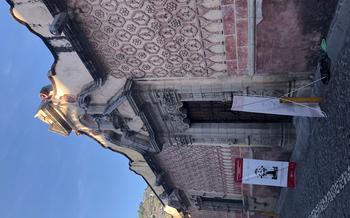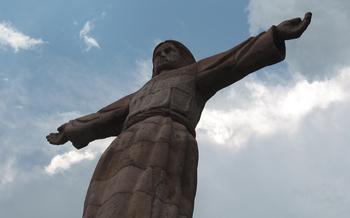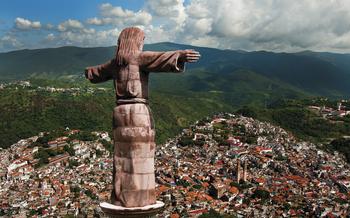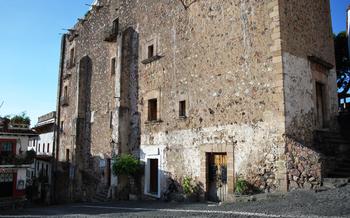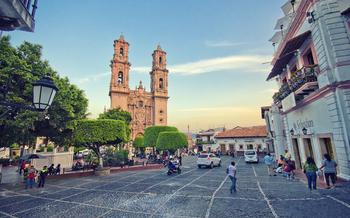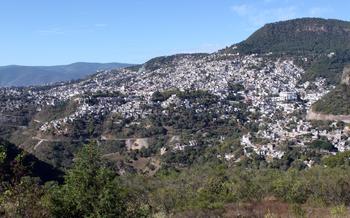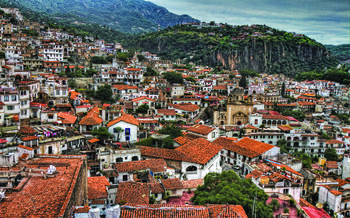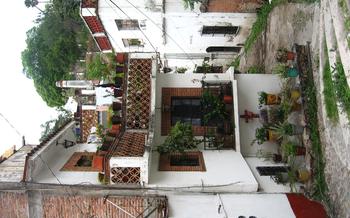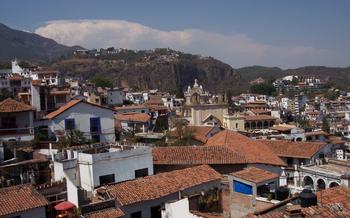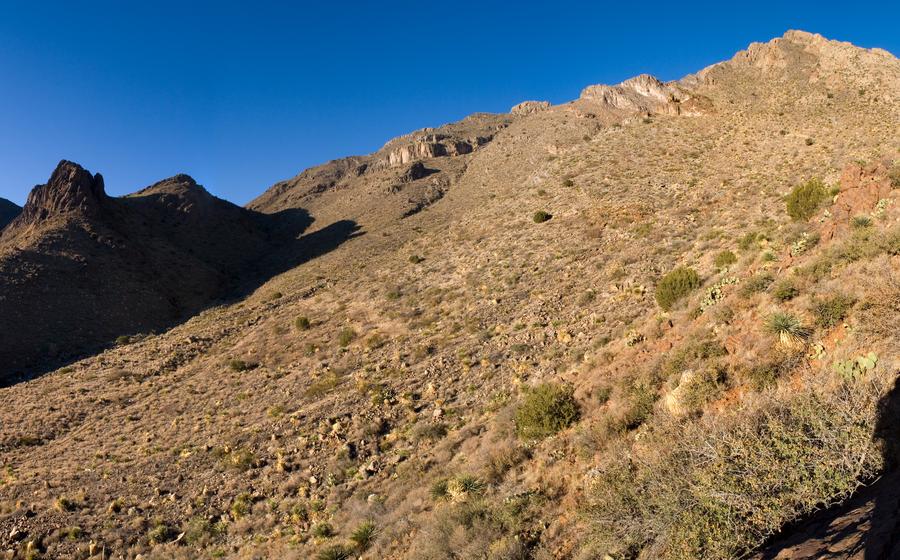
Quinta Luz Museum
- A Journey Through History
- Unveiling the Collection
- The Spratling Legacy
- Interactive Experiences
- Art Exhibitions and Events
- Guided Tours
- Museum Store
- Surrounding Attractions
- Accessibility and Facilities
- Photography and Social Media
- Educational Programs
- Conservation and Restoration
- Research and Publications
- Community Engagement
- Insider Tip
A Journey Through History
In the heart of Taxco, nestled amidst narrow cobblestone streets and colonial buildings, lies the Quinta Luz Museum, a testament to the artistic and cultural legacy of Mexico. Founded in 1951 by American artist and silversmith William Spratling, the museum is housed in a beautifully restored 18th-century mansion that once belonged to a wealthy silver baron. Spratling, captivated by the charm and artistry of Taxco, made it his home and dedicated his life to promoting Mexican art and culture on the international stage.
The Quinta Luz Museum, a reflection of Spratling's passion, showcases an extensive collection of pre-Columbian artifacts, colonial art, and contemporary Mexican artwork. The museum's unique architectural style, blending colonial and Mexican elements, creates a harmonious setting for the diverse collection. As a symbol of cultural exchange, the Quinta Luz Museum stands as a bridge between Mexico's rich past and its vibrant present, inviting visitors to embark on a journey through the depths of Mexican art and history.
Unveiling the Collection
The Quinta Luz Museum houses an extensive collection of pre-Columbian artifacts that offer a glimpse into the rich cultural heritage of ancient Mexican civilizations. The collection encompasses a diverse range of objects, including intricate pottery, finely crafted sculptures, and ceremonial masks. Among the highlights are rare and unique pieces, such as a colossal stone head believed to date back to the Olmec civilization, and a delicate gold ornament depicting the Aztec god Quetzalcoatl. These artifacts provide valuable insights into the beliefs, customs, and artistic traditions of the ancient peoples who inhabited the region. The museum's collection has played a significant role in the study of Mexican history and archaeology, contributing to a deeper understanding of the development and evolution of these ancient societies.
The Spratling Legacy
William Spratling's influence extended far beyond the walls of the Quinta Luz Museum. He was a tireless advocate for Mexican art and culture, and his contributions to the promotion of Mexican silverwork and jewelry on the international stage were immense. Spratling's designs, inspired by pre-Columbian motifs and traditional Mexican craftsmanship, gained global recognition, and he played a pivotal role in establishing the reputation of Mexican silver as a symbol of artistic excellence.
Throughout his career, Spratling mentored and trained numerous Mexican artists and artisans, passing on his knowledge and skills to a new generation of creatives. His workshops and apprenticeships provided opportunities for aspiring artists to learn from a master craftsman and develop their own unique styles. Spratling's legacy lives on through the work of his apprentices, who continue to uphold his commitment to preserving and promoting Mexican cultural heritage.
Beyond his artistic contributions, Spratling was also a passionate advocate for the preservation of Mexico's cultural traditions. He was instrumental in establishing the Mexican Arts and Crafts Society, an organization dedicated to supporting and promoting Mexican artisans and their work. Spratling's tireless efforts helped to raise awareness of the importance of preserving Mexico's rich cultural heritage and ensuring that traditional crafts continued to thrive.
Interactive Experiences
The Quinta Luz Museum offers a range of engaging activities and interactive exhibits that enhance the museum visit and promote cultural immersion. Visitors can participate in workshops and classes on traditional Mexican arts and crafts, such as pottery, weaving, and jewelry making. These workshops provide a hands-on opportunity to learn about Mexican culture and traditions while creating their own unique artwork.
The museum also encourages visitors to create their own artwork inspired by the museum's collection. There are designated spaces within the museum where visitors can sketch, paint, or sculpt, using materials provided by the museum. This interactive experience allows visitors to connect with the artworks on a deeper level and express their own creativity.
The Quinta Luz Museum's interactive experiences are designed to make the museum visit more engaging and memorable. They provide visitors with a unique opportunity to learn about Mexican culture, create their own artwork, and connect with the museum's collection in a meaningful way.
Art Exhibitions and Events
The Quinta Luz Museum is not only home to a remarkable permanent collection but also hosts a vibrant calendar of temporary art exhibitions. These exhibitions showcase the works of both established and emerging Mexican artists, providing visitors with a glimpse into the diverse and dynamic contemporary art scene in Mexico.
The museum's temporary exhibitions cover a wide range of artistic styles, mediums, and themes, from traditional Mexican folk art to cutting-edge contemporary installations. Solo shows highlight the work of individual artists, while group exhibitions bring together the works of multiple artists on a specific theme or concept. Thematic displays explore various aspects of Mexican history, culture, and society through the lens of art.
In addition to art exhibitions, the museum also hosts special events and cultural programs throughout the year. These events include concerts, lectures, workshops, and film screenings, all of which are designed to engage visitors with Mexican culture and heritage in new and interactive ways. These events often feature collaborations with local artists, musicians, and scholars, creating a dynamic and interdisciplinary cultural experience.
The museum's art exhibitions and events contribute to its vibrant cultural scene and attract visitors from all over the world. They offer a platform for Mexican artists to showcase their work, promote cultural exchange, and foster a deeper understanding of Mexican art and culture among visitors.
Guided Tours
The Quinta Luz Museum offers guided tours in various languages to enhance the visitor experience. Knowledgeable museum guides lead these tours, providing insightful commentary and highlighting the museum's key attractions. Visitors can choose from a range of tour options, including general overviews, thematic tours focusing on specific aspects of the collection, and customized tours tailored to their interests.
These guided tours offer a deeper understanding of the museum's collection and its significance in Mexican art and culture. Guides share historical anecdotes, explain the techniques and styles of the artworks, and provide context for the various periods and cultures represented in the collection. They also point out hidden details and lesser-known stories behind the artifacts, bringing the museum's treasures to life for visitors.
Whether you're an art enthusiast, a history buff, or simply curious about Mexican culture, the guided tours at the Quinta Luz Museum are an excellent way to maximize your visit. They offer a personalized and engaging experience that allows you to delve into the museum's rich collection and gain a deeper appreciation for the artistic and cultural heritage of Mexico.
Museum Store
The Quinta Luz Museum's store is a treasure trove of unique souvenirs, handicrafts, and art pieces that celebrate Mexican culture and heritage. Visitors can browse a wide selection of items inspired by the museum's collection, including replicas of ancient artifacts, traditional pottery, hand-woven textiles, and exquisite silver jewelry.
By purchasing from the museum store, visitors not only take home a piece of Mexican artistry but also support local artisans and the museum's educational programs. The revenue generated from sales helps sustain the museum's operations and ensures the preservation of its invaluable collection for future generations.
The store also offers a variety of books, catalogs, and publications related to Mexican art, history, and archaeology. These publications provide visitors with deeper insights into the museum's collection and the rich cultural heritage of Mexico.
Whether you're looking for a unique souvenir, a special gift, or a piece of art to adorn your home, the Quinta Luz Museum store is a must-visit for art enthusiasts and culture lovers.
Surrounding Attractions
Nestled in the heart of the charming city of Taxco, the Quinta Luz Museum is surrounded by a wealth of historical landmarks, cultural attractions, and picturesque streets. Take a leisurely stroll around the neighborhood and discover the beauty of Taxco's colonial architecture, including the iconic Santa Prisca Church, renowned for its elaborate Churrigueresque facade. Visit the nearby William Spratling Museum, dedicated to the life and work of the museum's founder, and delve deeper into his contributions to Mexican art and culture.
For a taste of local history, explore the Silver Museum, showcasing the rich history of silver mining in Taxco and the region's renowned craftsmanship. Immerse yourself in the vibrant atmosphere of the Zócalo, Taxco's main square, where you can soak in the charm of colonial buildings, browse local markets, and enjoy traditional Mexican cuisine at nearby restaurants.
Don't miss the opportunity to wander through the narrow cobblestone streets lined with charming shops and galleries, where you can find unique souvenirs, handicrafts, and locally made jewelry. Experience the warmth and hospitality of the local community as you engage with friendly vendors and artisans, gaining insights into Taxco's rich cultural traditions.
Accessibility and Facilities
The Quinta Luz Museum welcomes visitors from all walks of life and strives to create an inclusive and accessible environment for all. The museum's facilities are designed to accommodate visitors with disabilities, ensuring that everyone can enjoy and appreciate the museum's collection and programs.
Wheelchair access is available throughout the museum, with ramps and elevators providing easy navigation. Accessible restrooms are also available within the museum for the convenience of visitors.
For visitors who require additional assistance, the museum offers guided tours that can be customized to meet their needs and interests. Museum guides are knowledgeable and experienced in providing tours for visitors with disabilities, ensuring that everyone has a meaningful and enriching experience.
The museum also provides a range of amenities to enhance the visitor experience. A cafe is located within the museum, offering refreshments and snacks for visitors to enjoy. A museum store is also available, where visitors can purchase souvenirs, handicrafts, and art pieces inspired by the museum's collection and Mexican culture.
The museum is conveniently located and easily accessible by public transportation. Parking options are available nearby for visitors who prefer to drive. The museum's website provides detailed information on accessibility features, facilities, and transportation routes to help visitors plan their visit.
By creating an accessible and welcoming environment, the Quinta Luz Museum ensures that everyone can experience and appreciate the beauty and richness of Mexican art and culture.
Photography and Social Media
The Quinta Luz Museum encourages visitors to capture their experience through photography and share it on social media.
Visitors are allowed to take photographs of the museum's collection and exhibitions for personal use, but flash photography is not permitted to preserve the integrity of the artworks.
The museum promotes the use of social media to spread awareness about its collection and mission. Visitors can share their photos and experiences on platforms like Instagram, Facebook, and Twitter using the hashtag #QuintaLuzMuseum.
The museum's social media accounts (@Quintaluzmuseum) showcase highlights from the collection, behind-the-scenes glimpses, upcoming events, and educational content.
By engaging with the museum on social media, visitors can connect with a global community of art enthusiasts, learn more about Mexican culture, and contribute to the museum's outreach efforts.
Educational Programs
The Quinta Luz Museum is committed to promoting cultural awareness and appreciation through its educational initiatives. These programs cater to students of all ages, as well as the general public, providing a platform for hands-on learning and engagement with Mexican art and culture.
The museum offers a variety of workshops, lectures, and outreach programs designed to foster a deeper understanding of Mexico's rich cultural heritage. These programs cover diverse topics, including Mexican history, archaeology, traditional arts and crafts, and contemporary art.
The museum collaborates closely with schools and educational institutions to provide resources and experiences that enhance classroom learning. Through field trips, guided tours, and interactive workshops, students can immerse themselves in the museum's collection and gain valuable insights into Mexican culture.
The Quinta Luz Museum's educational programs play a vital role in cultivating a new generation of cultural enthusiasts and advocates. By promoting cultural awareness and appreciation, the museum contributes to the education and cultural development of the community, ensuring that Mexico's rich cultural heritage continues to thrive.
Conservation and Restoration
The Quinta Luz Museum is committed to the preservation and conservation of its priceless collection of Mexican artifacts. A dedicated team of conservators employs specialized techniques and methodologies to ensure the integrity and longevity of these invaluable artworks. Their meticulous work involves stabilizing and restoring damaged artifacts, cleaning and protecting surfaces, and conducting ongoing monitoring to detect and address any potential threats to their condition.
The museum's conservation efforts extend beyond its own collection. It also provides expertise and guidance to other institutions and organizations working to preserve Mexico's cultural heritage. Through workshops, training programs, and collaborations, the Quinta Luz Museum plays a crucial role in promoting best practices in conservation and ensuring that future generations can continue to appreciate and learn from Mexico's rich cultural legacy.
Research and Publications
The Quinta Luz Museum is not only a repository of Mexican art and culture but also a hub for research and scholarship. The museum's extensive collection and in-house expertise have facilitated the production of numerous publications, journals, and research papers that have contributed significantly to the study of Mexican history and archaeology.
The museum collaborates with scholars and institutions from around the world to conduct research and produce publications that shed light on various aspects of Mexican culture. These publications cover a wide range of topics, including pre-Columbian art, colonial-era painting, and contemporary Mexican art. The museum's journals and research papers are widely recognized for their rigor and contribute to the advancement of knowledge in the field.
By engaging in research and publishing its findings, the Quinta Luz Museum plays a crucial role in disseminating knowledge and understanding of Mexican culture. The museum's publications are disseminated to libraries, universities, and research institutions worldwide, ensuring that the rich cultural heritage of Mexico is accessible to scholars and the general public alike.
Community Engagement
The Quinta Luz Museum extends its influence beyond its walls through various community engagement initiatives. It fosters a sense of cultural pride and identity within the local community by partnering with local organizations and initiatives dedicated to preserving and promoting Mexican cultural heritage. These partnerships involve educational programs, workshops, and events that engage the community in hands-on experiences and cultural exploration. The museum's commitment to community outreach ensures that the rich traditions and history of Mexican art and culture are accessible and celebrated by all.
Insider Tip
Beyond the main galleries and exhibits, the Quinta Luz Museum holds hidden gems that offer a deeper dive into its history and collection. One such gem is the museum's rooftop terrace, which provides breathtaking panoramic views of Taxco and the surrounding mountains. Visitors can soak in the scenery, capture stunning photographs, and appreciate the museum's unique architectural features from a different perspective.
Another hidden gem is the museum's library, which houses a vast collection of books, manuscripts, and documents related to Mexican art, history, and culture. This treasure trove of knowledge is open to researchers and visitors who wish to delve deeper into the subjects that the museum showcases.
To make the most of your visit, consider joining one of the museum's guided tours. Led by knowledgeable experts, these tours offer insights into the museum's collection, the life of William Spratling, and the history of Taxco. Tours can be customized based on your interests, ensuring a personalized and enriching experience.
Finally, don't miss the opportunity to visit the museum's gift shop, which offers a unique selection of souvenirs, handicrafts, and art pieces inspired by the museum's collection and Mexican culture. Your purchases not only serve as mementos of your visit but also support local artisans and the museum's educational programs.
